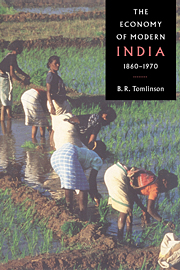Book contents
- Frontmatter
- 1 Introduction: development and underdevelopment in colonial India
- 2 Agriculture 1860–1950: land, labour and capital
- 3 Trade and manufacture, 1860–1945: firms, markets and the colonial state
- 4 The state and the economy, 1939–1970: the emergence of economic management in India
- 5 Conclusion
- Bibliographical essay
- Index
- THE NEW CAMBRIDGE HISTORY OF INDIA
- Map I.I India in 1937-8
- References
4 - The state and the economy, 1939–1970: the emergence of economic management in India
Published online by Cambridge University Press: 28 March 2008
- Frontmatter
- 1 Introduction: development and underdevelopment in colonial India
- 2 Agriculture 1860–1950: land, labour and capital
- 3 Trade and manufacture, 1860–1945: firms, markets and the colonial state
- 4 The state and the economy, 1939–1970: the emergence of economic management in India
- 5 Conclusion
- Bibliographical essay
- Index
- THE NEW CAMBRIDGE HISTORY OF INDIA
- Map I.I India in 1937-8
- References
Summary
The independent India that came into existence on 15 August 1947 was a large, diverse and poor country that inherited many economic problems from its colonial past. It was operating within novel political boundaries, and the separation of sizeable areas of the north-western and north-eastern areas of British India to create the new state of Pakistan created some important economic difficulties and dislocations, especially in the supply of Punjabi wheat and Bengali jute. The Indian Union had a federal constitution, with powers over economic policy split between the central government in New Delhi and the state administrations. In several parts of the country, notably in central and western India, the administrative units were made more unwieldy by the problems of incorporating the old Princely States into the new administrative system, and of meeting demands for the creation of linguistically based states out of the old provincial administrative units of British India. This process continued throughout the first thirty years of Independence, resulting in the boundaries and units shown on the political map of contemporary India in map 4.1. The Indian economy at Independence was, as we have already seen, largely agricultural, with over four-fifths of the population living in rural areas, and only about 10 per cent working in the manufacturing sector. The economy was also strongly regionalised, with important differences in resources and sectoral distribution in different parts of the country. Some indicators of the regional diversity of the economy in the early 1950s are given in table 4.1, while map 4.2 shows the sectoral distribution of the labour force and per capita income for the whole subcontinent in 1961.
Keywords
- Type
- Chapter
- Information
- The Economy of Modern India, 1860–1970 , pp. 156 - 213Publisher: Cambridge University PressPrint publication year: 1993



